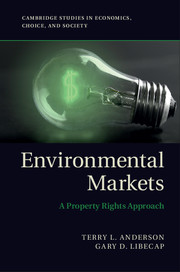Book contents
- Frontmatter
- Contents
- List of Figures and Tables
- Preface
- Acknowledgments
- 1 Who Owns the Environment?
- 2 Is Government Regulation the Solution?
- 3 Property Rights for the Common Pool
- 4 Local Property Rights to the Commons
- 5 The Politics of Property Rights
- 6 From Property Rights to Markets
- 7 Tackling the Global Commons
- 8 Property Rights and Environmental Markets
- Index
- References
6 - From Property Rights to Markets
Published online by Cambridge University Press: 05 July 2014
- Frontmatter
- Contents
- List of Figures and Tables
- Preface
- Acknowledgments
- 1 Who Owns the Environment?
- 2 Is Government Regulation the Solution?
- 3 Property Rights for the Common Pool
- 4 Local Property Rights to the Commons
- 5 The Politics of Property Rights
- 6 From Property Rights to Markets
- 7 Tackling the Global Commons
- 8 Property Rights and Environmental Markets
- Index
- References
Summary
Whether property rights evolve from the bottom up or are assigned directly by government, they can provide important benefits by supporting environmental markets. Chapters 3 and 4 provided examples of the evolution of informal property rights and their role in providing environmental quality. In this chapter we turn to cases where environmental markets are based on formal property rights codified through a political and legal process. The examples are water rights, conservation credits, emission allowances, and tradable fishery shares. The details illustrate how environmental markets work and the nature of the property rights underwriting them.
In all of the cases, the rights are not based on fee simple titles but instead are use privileges. This distinction is important because privileges are just that, use opportunities that can be modified, reassigned, or revoked more easily by political or judicial action than is the case with formal title. Political action occurs through Congress and regulatory agencies, and judicial review through the courts. Use privileges have no constitutional takings protections, and monetary losses from government interventions are not compensable. Although use privileges give regulatory agencies greater flexibility, they are more uncertain and can have shorter time horizons and weaker incentives for investing in or reallocating the environmental resource than can more secure formal rights. When property rights are vague, environmental markets are weakened, and more environmental benefits must come from command-and-control regulation and tax policies. We examined the problems with those approaches in Chapters 2 and 3. A major lesson of this chapter is that property rights must be protected from regulatory takings if we are to harness markets to improve environmental quality. We provide examples of successful markets, some emerging ones, and some that have been weakened by political and bureaucratic intervention. This range of experiences reveals what is possible, what more remains, and what dangers can arise. We begin with two successful instances regarding water.
- Type
- Chapter
- Information
- Environmental MarketsA Property Rights Approach, pp. 134 - 172Publisher: Cambridge University PressPrint publication year: 2014



